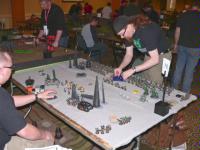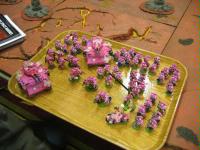by Redbeard
Tips and Tricks for playing your horde army quickly in a tournament setting
I took a 200 model army to Adepticon 2008, and was able to complete at least five turns in all my games. What follows are some tricks that I found helpful to keep things running smoothly.
Before the Tournament
Running a horde quickly requires preparation even before you go to the tournament. Your army has to be designed for easy play.
First, realize that with as many models as you're going to run, you're going to need to be able to tell them apart on the tabletop, and you're going to need to do it quickly. They key here is to use really obvious squad markings.
If you're running an Ork army, going with bright clothing can really help. For armies with a more uniform look to their squads (Tyranids), you might consider painting each squad's base edge a different colour. This does make a big difference over the course of a game. As you can see in the image below, even with the models packed closely together, in a small picture, you can tell the squads colouring apart easily.

Also, practice with your army. You should have played your horde army at least ten times before you bring it to a tournament. Practice playing with a timer at home. Your average tournament round is 2 hours. That means you get about an hour to play your turns. Six rounds means 10 minute turns. Can you move all the models in your army in ten minutes?
Also, pre-plan deployments. You're running a horde, so your deployment really shouldn't change much from game to game, especially not the main horde elements. So, have an idea how you intend to deploy so you don't have to think about it during games.
During Games
If you're running a horde, you know your guys only move 6". Get something six inches long and use it, instead of a tape measure to do your movement. It's really easy for both you and your opponent to see. I used a GaleForce 9 blue movement thing. That also makes it really obvious to your opponent that you're not cheating movement, so that's a good thing. It also has a two-inch side, for unit coherency, so you can do that quickly.

Galeforce 9 movement tool in use
Don't waste time arguing with your opponent. If they're wrong about a rule, unless it means the game, let them have it - you have to finish the game in two hours and spending ten minutes proving you're right isn't going to help you do that. You're running a horde, and odds are, if they kill one or two more of your models, it won't make a big difference.
Do think your moves through during your opponent's turn. When your turn starts, you should be ready to start moving models, not thinking about where they're going to go.
Do know your rules. If you need to look up your weapon ranges or damages during a game, perhaps a horde isn't the right army for you. Play more practice games until you know these things by heart.
Know your dice. In an Ork army, 3 boyz can have a special weapon. So, I have three differently coloured dice. Knowing that I have 33 green dice means that when I need to roll 15 shootaboy's attacks, I can take out the three rokkit dice and three green dice, and have 30 ready to roll, instead of counting up to 30.
As your boyz are generally swinging last anyway, with your opponent's consent, roll your powerklaw first. Sometimes, this isn't feasible, such as if your opponent has the opportunity to deny your powerklaw attacks with casualty removal, but if you have 10 boyz and a nob fighting a chaplain, go ahead and roll those powerklaws first - if one of them gets through, you don't need to roll the 30 other attacks.
Be friendly, but keep things moving. If your opponent is wasting time, nudge them, remind them that the round is only two hours. If you suspect that they're deliberately slow-playing don't hesitate to call a judge over.
Do not start a turn if both players will not get their turn. Pay attention to time throughout the tournament. If you find that the average turn is taking you 30 minutes, and you have 25 minutes to go, you either need to play faster during the last turns, or not take them. With that in mind, as the horde player, you should start considering moving your objective-grabbing units towards the objectives when there's about a half-hour to go.
Between Rounds
Between rounds make sure your army is reassembled so that you can easily deploy it again for the next game. Take care of bathroom and food breaks early in the between-round time, because you're going to want that time in the next game you play. Showing up for game two five minutes late with your army jumbled together in whatever order the casualties occurred in game one is going to mean you only get seven minutes per turn in game two, and that's not going to be enough.

Use any kind of tray you can find!
yakface sez: To reiterate what Redbeard is saying about in between rounds, you really must bring some sort of tray to carry your models from table to table without putting them back in the case, even if means bringing a simple meal tray. You just cannot afford the massive amount of time it takes to put away and take back out the models from their cases. Having your army on a tray means that you'll be able to deploy in less time which means you gain precious minutes that can be spent actually playing the game.
To reiterate what Redbeard is saying about in between rounds, you really must bring some sort of tray to carry your models from table to table without putting them back in the case, even if means bringing a simple meal tray. You just cannot afford the massive amount of time it takes to put away and take back out the models from their cases. Having your army on a tray means that you'll be able to deploy in less time which means you gain precious minutes that can be spent actually playing the game.
It even helps to pay attention to where you put your casualties during the game. If you place them directly into their specific position on your carrying tray then by the time the game is over you've already gotten half or more of your army into place for transport. The more meticulous you are removing your casualties from the game the quicker you'll be in between rounds and the more amount of time you'll have to complete your games.